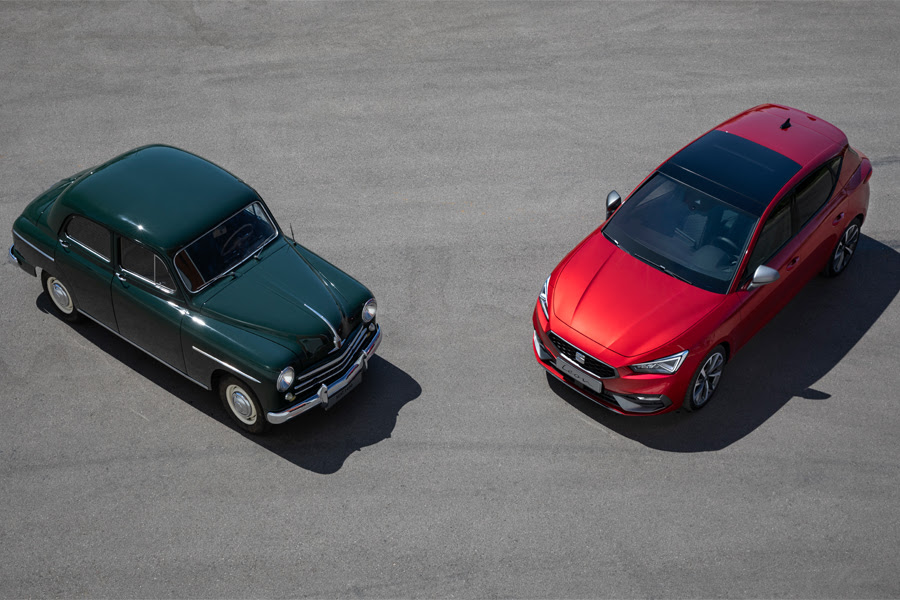Generation change
From the SEAT 1400 to the all-new Leon

- SEAT celebrates its 70th anniversary: from the SEAT 1400 to the all-new Leon
- The SEAT 1400, the luxurious and elegant saloon, marked the birth of the brand
- Today, the all-new SEAT Leon embodies the spirit of the 1400, taking the company to new places and helping define the segment with its approach to design, technology and innovation
Martorell, 09/06/2020. Since the very beginning, SEAT has launched vehicles that are designed and developed for the customer and their needs. When the SEAT 1400 was introduced in 1953 it offered a route to greater mobility levels with the stylised look of an American vehicle and the luxury and elegance that people wanted at the time.
Fast forward to today and the all-new SEAT Leon takes the spirit of the brand’s very first vehicle and encapsulates it in one of the most advanced vehicles ever to roll off the company’s production lines at its Martorell facilities.
But how has design and engineering evolved over the intervening 70 years?
Exterior design
Customer demands have shifted significantly over the decades. Where once we wanted chrome finishing and circular headlights, we now need a more integrated approach that merges aerodynamic need and aesthetic purity.
– Front view: Gone are the days of an obundance of chrome highlights and bulbous proportions, design has sculptered the frontal area to mix the needs of aesthetics and aerodynamics, to produce clean, crisp, cool look.
– Rearview: Small, almost invisible rear lights, elongated boots and small rear windows have made way for advanced, dynamic lighting that accentuates the design language of the all-new SEAT Leon.
– Side: Approaches have changed, in the 1950’s the SEAT 1400 demonstrates the tall, upright design, small wheels and an angled side on stance that was all the rage, fast forward to today and the all-new SEAT Leon highlights a more dynamic look, where the rake of the A-pillar, position of the shoulders and crips lines provide a sense of performance and confidence.
Interior design and space
– Seating: The SEAT 1400 highlights the practical nature of the time, where bench seating provided room for all both front and rear. But times have changed and the SEAT Leon’s front seats cocoon both driver and front passenger, offering optimum support and comfort even on the longest journeys. In the rear, passengers individual seating provides the perfect balance between comfort and versatility.
– Boot: In the 1950’s boots were big, but they had to be. The SEAT 1400 houses the spare wheel and access to the the refiller cap, losing some of its practicality. Today luggage space is maximised with deeper floors, and through modularity to the rear seats, which can be folded in different ways to increase the loading area.
Exterior styling
– Headlights: Large round two-strand lamp have given way to advanced LED technology giving greater creative freedom to designers to incorporate lighting into the language of the vehicle’s look.
– Tail lights: Small and functional lights have been replaced with dynamic, communicative lighting systems that highlight the personality of the vehicle, adding a new dimension to the rear design.
– Wheels: The large tyre walls, small steel rims and chrome hubcaps of the 1950’s have been replaced with larger, more intricate designs using lighter aluminium with lower profiles.
– Logo: Simplicity is key in SEAT story and the 1400’s logo echos that need, fast forward to 2020 and the all-new SEAT Leon uses a bolder, more robust logo, one that is an established and wellknown brand.
– Antenna: The SEAT 1400 was born in an analogue age where entertainment in the vehicle was more of a novelty than a expectation. Today the digitalisation of our lives means that a plethora of radio stations transmit across continents, and the SEAT Leon can capture them all.
Interior look and feel
– Dashboard: Much like other areas analogue was king in the SEAT 1400 where minimal information was provided. Today, with the range of onboard systems available on the SEAT Leon, more information can be shown in better clarity, and customised to the individual user thanks to digital, configurable screen technology.
– Steering wheel: The primary link between driver and vehicle. In the 1950’s it was a simple, thin two-spoke affair designed solely for directing the wheel. The modern age has brought greater tactility and ergonomic design as well as multifunctional controls allowing the driver to take command of a host of functions.
– Infotainment: A radio tuneable to a minimal number of stations was as advanced as it was in the 1400’s era, today the all-new SEAT Leon is one of the most connected cars the brand has ever made. Plugged into our digital lives, we can take our smart devices into the cabin, connect them and access all our apps, contacts and media through the high-definition infotainment system.
– Gearshift: The column-mounted gearstick in the SEAT 1400 made the shifting gears in the four-speed transmission simpler, but shift-by-wire technology means that the SEAT Leon benefits from slick shifts no matter what the driving conditions, and the technology also helps free space, giving more room for occupants and storage.
– Trim: Options were minimal on the SEAT 1400, but today the list is endless, meaning customers can chose the trims and options to make the car suit their personalities and lifestyles.
Powertrain
– Engines: The SEAT 1400 boasted an inline four-cylinder petrol engine with a displacement of 1,395cc, producing 44hp at 4,400 rpm giving it a top speed of 125km/h and average consumption of 10.5litres/100 km. Nowadays, engines e6fficiency is key to success, and the all-new SEAT Leon integrates mild-hybrid technology to maximise fuel efficiency.
The 1.5 litre, four-cylinder TSI mHEV unit adds 48V mild-hybrid technology to the combustion engine meaning it can reach 221km/h but use as little as 5.6-6.4 litres/100km (WLTP).





